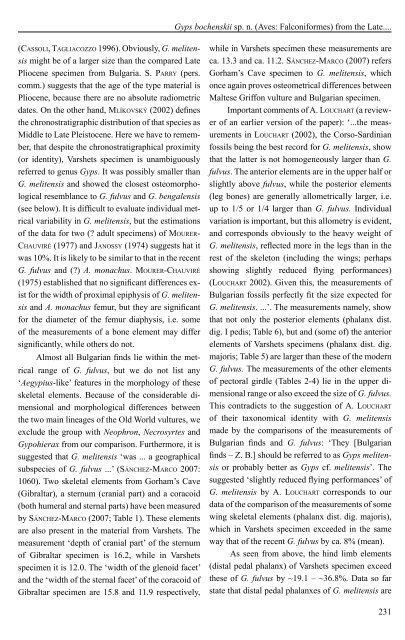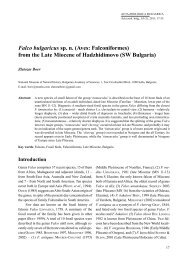Gyps bochenskii sp. n. (Aves: Falconiformes) from the Late ... - ecodb
Gyps bochenskii sp. n. (Aves: Falconiformes) from the Late ... - ecodb
Gyps bochenskii sp. n. (Aves: Falconiformes) from the Late ... - ecodb
Create successful ePaper yourself
Turn your PDF publications into a flip-book with our unique Google optimized e-Paper software.
<strong>Gyps</strong> <strong>bochenskii</strong> <strong>sp</strong>. n. (<strong>Aves</strong>: <strong>Falconiformes</strong>) <strong>from</strong> <strong>the</strong> <strong>Late</strong>....<br />
(CASSOLI, TAGLIACOZZO 1996). Obviously, G. melitensis<br />
might be of a larger size than <strong>the</strong> compared <strong>Late</strong><br />
Pliocene <strong>sp</strong>ecimen <strong>from</strong> Bulgaria. S. PARRY (pers.<br />
comm.) suggests that <strong>the</strong> age of <strong>the</strong> type material is<br />
Pliocene, because <strong>the</strong>re are no absolute radiometric<br />
dates. On <strong>the</strong> o<strong>the</strong>r hand, MLÍKOVSKÝ (2002) defines<br />
<strong>the</strong> chronostratigraphic distribution of that <strong>sp</strong>ecies as<br />
Middle to <strong>Late</strong> Pleistocene. Here we have to remember,<br />
that de<strong>sp</strong>ite <strong>the</strong> chronostratigraphical proximity<br />
(or identity), Varshets <strong>sp</strong>ecimen is unambiguously<br />
referred to genus <strong>Gyps</strong>. It was possibly smaller than<br />
G. melitensis and showed <strong>the</strong> closest osteomorphological<br />
resemblance to G. fulvus and G. bengalensis<br />
(see below). It is difficult to evaluate individual metrical<br />
variability in G. melitensis, but <strong>the</strong> estimations<br />
of <strong>the</strong> data for two (? adult <strong>sp</strong>ecimens) of MOURER-<br />
CHAUVIRÉ (1977) and JANOSSY (1974) suggests hat it<br />
was 10%. It is likely to be similar to that in <strong>the</strong> recent<br />
G. fulvus and (?) A. monachus. MOURER-CHAUVIRÉ<br />
(1975) established that no significant differences exist<br />
for <strong>the</strong> width of proximal epiphysis of G. melitensis<br />
and A. monachus femur, but <strong>the</strong>y are significant<br />
for <strong>the</strong> diameter of <strong>the</strong> femur diaphysis, i.e. some<br />
of <strong>the</strong> measurements of a bone element may differ<br />
significantly, while o<strong>the</strong>rs do not.<br />
Almost all Bulgarian finds lie within <strong>the</strong> metrical<br />
range of G. fulvus, but we do not list any<br />
‘Aegypius-like’ features in <strong>the</strong> morphology of <strong>the</strong>se<br />
skeletal elements. Because of <strong>the</strong> considerable dimensional<br />
and morphological differences between<br />
<strong>the</strong> two main lineages of <strong>the</strong> Old World vultures, we<br />
exclude <strong>the</strong> group with Neophron, Necrosyrtes and<br />
Gypohierax <strong>from</strong> our comparison. Fur<strong>the</strong>rmore, it is<br />
suggested that G. melitensis ‘was ... a geographical<br />
sub<strong>sp</strong>ecies of G. fulvus ...’ (SÁNCHEZ-MARCO 2007:<br />
1060). Two skeletal elements <strong>from</strong> Gorham’s Cave<br />
(Gibraltar), a sternum (cranial part) and a coracoid<br />
(both humeral and sternal parts) have been measured<br />
by SÁNCHEZ-MARCO (2007; Table 1). These elements<br />
are also present in <strong>the</strong> material <strong>from</strong> Varshets. The<br />
measurement ‘depth of cranial part’ of <strong>the</strong> sternum<br />
of Gibraltar <strong>sp</strong>ecimen is 16.2, while in Varshets<br />
<strong>sp</strong>ecimen it is 12.0. The ‘width of <strong>the</strong> glenoid facet’<br />
and <strong>the</strong> ‘width of <strong>the</strong> sternal facet’ of <strong>the</strong> coracoid of<br />
Gibraltar <strong>sp</strong>ecimen are 15.8 and 11.9 re<strong>sp</strong>ectively,<br />
while in Varshets <strong>sp</strong>ecimen <strong>the</strong>se measurements are<br />
ca. 13.3 and ca. 11.2. SÁNCHEZ-MARCO (2007) refers<br />
Gorham’s Cave <strong>sp</strong>ecimen to G. melitensis, which<br />
once again proves osteometrical differences between<br />
Maltesе Griffon vulture and Bulgarian <strong>sp</strong>ecimen.<br />
Important comments of A. LOUCHART (a reviewer<br />
of an earlier version of <strong>the</strong> paper): ‘...<strong>the</strong> measurements<br />
in LOUCHART (2002), <strong>the</strong> Corso-Sardinian<br />
fossils being <strong>the</strong> best record for G. melitensis, show<br />
that <strong>the</strong> latter is not homogeneously larger than G.<br />
fulvus. The anterior elements are in <strong>the</strong> upper half or<br />
slightly above fulvus, while <strong>the</strong> posterior elements<br />
(leg bones) are generally allometrically larger, i.e.<br />
up to 1/5 or 1/4 larger than G. fulvus. Individual<br />
variation is important, but this allometry is evident,<br />
and corre<strong>sp</strong>onds obviously to <strong>the</strong> heavy weight of<br />
G. melitensis, reflected more in <strong>the</strong> legs than in <strong>the</strong><br />
rest of <strong>the</strong> skeleton (including <strong>the</strong> wings; perhaps<br />
showing slightly reduced flying performances)<br />
(LOUCHART 2002). Given this, <strong>the</strong> measurements of<br />
Bulgarian fossils perfectly fit <strong>the</strong> size expected for<br />
G. melitensis. ...’. The measurements namely, show<br />
that not only <strong>the</strong> posterior elements (phalanx dist.<br />
dig. I pedis; Table 6), but and (some of) <strong>the</strong> anterior<br />
elements of Varshets <strong>sp</strong>ecimens (phalanx dist. dig.<br />
majoris; Table 5) are larger than <strong>the</strong>se of <strong>the</strong> modern<br />
G. fulvus. The measurements of <strong>the</strong> o<strong>the</strong>r elements<br />
of pectoral girdle (Tables 2-4) lie in <strong>the</strong> upper dimensional<br />
range or also exceed <strong>the</strong> size of G. fulvus.<br />
This contradicts to <strong>the</strong> suggestion of A. LOUCHART<br />
of <strong>the</strong>ir taxonomical identity with G. melitensis<br />
made by <strong>the</strong> comparisons of <strong>the</strong> measurements of<br />
Bulgarian finds and G. fulvus: ‘They [Bulgarian<br />
finds – Z. B.] should be referred to as <strong>Gyps</strong> melitensis<br />
or probably better as <strong>Gyps</strong> cf. melitensis’. The<br />
suggested ‘slightly reduced flying performances’ of<br />
G. melitensis by A. LOUCHART corre<strong>sp</strong>onds to our<br />
data of <strong>the</strong> comparison of <strong>the</strong> measurements of some<br />
wing skeletal elements (phalanx dist. dig. majoris),<br />
which in Varshets <strong>sp</strong>ecimen exceeded in <strong>the</strong> same<br />
way that of <strong>the</strong> recent G. fulvus by ca. 8% (mean).<br />
As seen <strong>from</strong> above, <strong>the</strong> hind limb elements<br />
(distal pedal phalanx) of Varshets <strong>sp</strong>ecimen exceed<br />
<strong>the</strong>se of G. fulvus by ~19.1 – ~36.8%. Data so far<br />
state that distal pedal phalanxes of G. melitensis are<br />
231





